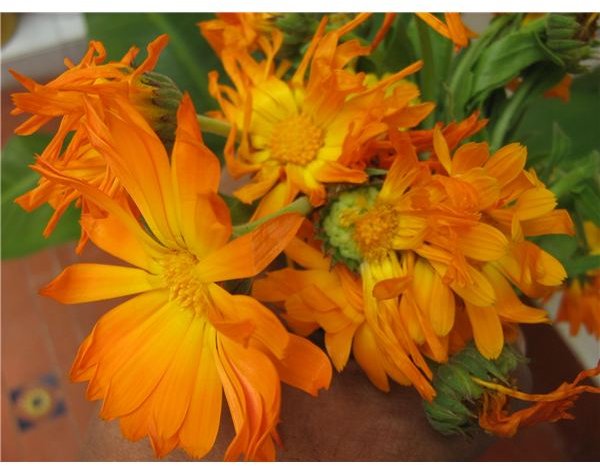The Healing Power of Flowers: Learn About the Science of Healing with Flowers
Healing With Flowers
These common blossoms are beautiful, fragrant and can help to cure what ails you. Simple, effective uses of some common flowers and how to make preparations and medicinal infusions that are used for curative purposes will be examined, discussed and explained. Healing properties of marigolds, sunflowers, chamomile (also known as Manzanilla), lillies or azucena, and pumpkin blossoms are some flowers to be considered here.
Healing Power of Marigold Flowers
A number of different types of wounds can be treated with a poultice made from ground up marigold leaves and flowers. An infusion made from the plant steeped in heated water is an effective treatment for inflammation of the eyes. Scientifically named Calendula oficinalis , this orange or yellow flower can also be used to reduce inflammation and abscesses of the gums and is often recommended by dentists in Latin American countries for a variety of inflammation treatments. The flower also has culinary and cosmetic uses as well, having been in extensive use for centuries in Europe and South America.
Healing with Sunflowers
Properly identified as Heliantus annuus, the sunflower is alternatively called Girasol in Spanish, Italian and Portuguese. The plant frequently reaches more than six feet in height. The seeds are usually consumed and the plant provides oil used in cooking and cosmetics. Medicinally, sunflowers, with their bright yellow flowers and central core of seeds, have diuretic and expectorant uses in addition to offering benefits of fever reduction when included in homeopathic preparations. Ground into paste and topically applied, it is used to treat stomach ailments and nasal hemmoraging. For treatment of colds and fever, dried sunflowers are soaked in alcohol for about 10 days, then strained filtered and taken as drops in water every three hours. The seeds can be eaten dried or toasted and aid in reducing cholesterol levels.
Healing Power of Chamomile Flowers
Chamomile, which is also often known as Manzanilla, has the scientific name Matricaria chamomilla. The small white flowers with their gold-pistiled center, have a pleasant fragrance despite their bitter flavor. When the flowers are dried in open air, they should be stored for later use in a sealed plastic bag. The flower, in preparations, poultices and infusions, has dozens of medicinal and alternative medicne applications and is used world wide.
For indigestion, dried chamomile flowers are soaked in white wine for approximately five days before filtering, then two tablespoons of the preparation are taken. Drinking a cup of dried chamomile flowers in a water infusion is a frequently-employed remedy for ailments including insomnia, menstrual cramps, stomach aches and menopause.
A highly effective massage ointment useful for treatment of dry, irritated skin of even a baby can be made by putting whole chamomile flowers into a glass container of olive oil, sunflower oil or flax seed oil for around two weeks while exposed to direct sunlight, before straining and storage.
Healing Power of Lillies
The long white petals of the lily (Lilium candidum) are known world wide. The flower has more than 50 known species and variations. An infusion of dried leaves and flowers of the lily can be used as a disinfectant when immersed in a clear liquor such as aguardiente, gin, vodka, etc. for about one week in a sealed, clear glass container. Arthritis and rheumatism preparations can be produced by immersing the bulbous roots and whole flowers in an oil such as sunflower oil, olive oil or other light organic oil, which is then strained. The remaining pulp has properties for treatment of stomach ailments and is an expectorant.
Healing with Pumpkin Flowers
Far beyond the heavy use of pumpkins during late fall, the large pumpkin flower has both medicinal and culinary uses. A highly nutritive and delicious food staple in countries such as Mexico and Guatemala, among numerous others, orange or sometimes yellow pumpkin flowers are fried, steamed and used in soups and on sandwiches. Their delicate but distinctive flavor is one I also personally enjoy. The flowers need to be harvested earlier in the growth cycle of the pumpkin (Cucurbita pepo), often in early to late summer. The alternative medicine properties are many but also include:
· Relief of digestive gases when the boiled flowers, leaves and pulp are soaked in water, strained, then consumed at intervals during the day.
· Control of Diarrhea when consumed as a strained infusion prepared as indicated previously.
· Burn treatment consists of washing, crushing and straining a batch of pumpkin leaves and flowers, then squeezing out the juice which can be applied directly to the burn. The fresh pulp can also be used as a plaster or poultice on a burn as well
· Inflammation of the urinary tract is effected by using the boiled flowers and seeds are soaked in water, strained, then consumed at intervals during the day.
· Treatment of stomach problems consists of consuming an infusion of pumpkin flowers, pulp, leaves and seeds with water at regular intervals during the day.
Healing With Flowers
These common blossoms discussed here are beautiful, fragrant and help to treat a variety of ailments. The effective use of flowers that heal can be as simple as making an infusion using boiled or heated water in which the flowers and other parts of the plant are steeped. Soaking flowers in vegetable oil before mincing the preparation to create a paste for use as a poultice is another technique discussed for benefiting from the healing properties of flowers. Why not try some for yourself?
Disclaimer
Please read the disclaimer regarding the information contained within this article.
